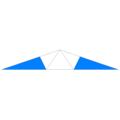Proportions
The triangles have two acute angles of  and one obtuse angle of
and one obtuse angle of  . The dihedral angle equals
. The dihedral angle equals  . Part of each triangle lies within the solid, hence is invisible in solid models.
. Part of each triangle lies within the solid, hence is invisible in solid models.
This page is based on this
Wikipedia article Text is available under the
CC BY-SA 4.0 license; additional terms may apply.
Images, videos and audio are available under their respective licenses.




